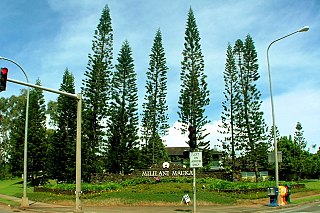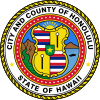
Honolulu is the capital and largest city of the U.S. state of Hawaiʻi. It is an unincorporated part of and the county seat of the City and County of Honolulu along the southeast coast of the island of Oʻahu. The city is the main gateway to Hawaiʻi and a major portal into the United States. The city is also a major hub for international business, military defense, as well as famously being host to a diverse variety of east-west and Pacific culture, cuisine, and traditions.

Mililani is a city located near the center of the island of Oʻahu in Honolulu County, Hawaiʻi, United States. It consists of two census-designated places, Mililani Town, with a population of 27,629 at the 2010 census, and Mililani Mauka, with a 2010 census population of 21,039.

Honolulu Hale, located on 530 South King Street in downtown Honolulu in the City & County of Honolulu, Hawaiʻi, is the official seat of government of the city and county, site of the chambers of the Mayor of Honolulu and the Honolulu City Council.
Jeremy Harris is an American politician who served as Mayor of Honolulu from 1994 to 2004. A biologist by training, Harris started his political career as a delegate to the 1978 Hawai'i State Constitutional Convention. While Harris served as chief executive of the City & County of Honolulu, the city was named "America's Greatest City" by the official American governance journal, Governing Magazine. Harris is the founder of the China-U.S. Conference of Mayors and Business Leaders and the Japan-American Conference of Mayors and Chamber of Commerce Presidents. He is married to Ramona Sachiko Akui Harris and lives in Kalihi Valley on the island of O'ahu.

Honolulu City Council is the legislature of the City and County of Honolulu, the capital and largest city of the U.S. state of Hawaiʻi. It is composed of nine members who are elected to a four-year terms. Each member can only serve no more than two consecutive terms. Members of the council are elected from nine administrative districts. Since 1991, the council reapportions council districts every ten years. Same as the mayor of the city, members of the council are elected by nonpartisan elections.

The Hawaiʻi State Public Library System (HSPLS) is the only statewide public library system in the United States. The flagship Hawaiʻi State Library, built in 1911 and designed by architect Henry D. Whitfield, was funded in part by industrialist and philanthropist Andrew Carnegie. It is a historic downtown Honolulu building. The system has 51 libraries on all the major Hawaiian Islands: Big Island of Hawaiʻi, Kauaʻi, Lānaʻi, Maui, Molokaʻi and Oʻahu. The system's collection of books and other library materials totals over three million. There is one library for the blind and physically handicapped, located on Oʻahu. The Hawaiʻi State Public Library System is headed by the Hawaiʻi State Librarian, currently Stacey Aldrich, who reports to the Hawaii Board of Education.

Mililani Trask is a leader of the Hawaiian Sovereignty Movement and a political speaker and attorney. One of Trask's contributions to the Hawaiian sovereignty movement was her founding of Na Koa Ikaika o Ka Lāhui Hawaiʻi, a native Hawaiian non-governmental organization.
Kamehameha Highway is one of the main highways serving suburban and rural O‘ahu in the U.S. state of Hawaii. Starting from Nimitz Highway near Pearl Harbor and Hickam Air Force Base in Honolulu, it serves the island's older western suburbs, turning north across the O‘ahu Central Valley to the North Shore. At the North Shore, Kamehameha Highway heads northeast around the northern tip of O‘ahu, then southeast to and just beyond Kāne‘ohe Bay on the windward coast. The road was named after King Kamehameha I.

Kalihi is a neighborhood of Honolulu on the island of Oʻahu in Hawaiʻi, United States. Split by the Likelike Highway, it is flanked by downtown Honolulu to the east and Mapunapuna, Moanalua and Salt Lake to the west.
Borough president is an elective office in each of the five boroughs of New York City. For most of the city's history, the office exercised significant executive powers within each borough, and the five borough presidents also sat on the New York City Board of Estimate. Since 1990, the borough presidents have been stripped of a majority of their powers in the government of New York City.

Honolulu County is a consolidated city–county in the U.S. state of Hawaii. The city–county includes both the city of Honolulu and the rest of the island of Oʻahu, as well as several minor outlying islands, including all of the Northwestern Hawaiian Islands except Midway Atoll.
Local government in New Jersey is composed of counties and municipalities. Local jurisdictions are simpler in New Jersey than in other states because every square foot of the state is part of exactly one municipality; each of the 565 municipalities is in exactly one county; and each of the 21 counties has more than one municipality. New Jersey has no unincorporated areas, independent cities, or consolidated city-counties.

The Honolulu Rail Transit Project is an urban rail rapid transit system under construction in Honolulu County, Oahu, Hawaii, U.S. The mostly-elevated system features design elements from both heavy rail systems and light metros, with a commuter rail-like design incorporated into trains and suburban stations. It will become the first large-scale publicly run metro system in the United States to feature platform screen doors and will be driverless. The first phase of the project, linking East Kapolei and Aloha Stadium, is scheduled to open in late 2020. Its second phase continuing the line across urban Honolulu to Ala Moana Center is due to open in December 2025.

The community boards of the New York City government are the appointed advisory groups of the community districts of the five boroughs. There are currently 59 community districts: twelve in Manhattan, twelve in the Bronx, eighteen in Brooklyn, fourteen in Queens, and three in Staten Island:

The Hawaii Pacific Baptist Convention (HPBC) is a group of churches affiliated with the Southern Baptist Convention located in the U.S. state of Hawaii and other pacific regions. Headquartered in Honolulu, it is made up of 138 churches on 11 islands in 6 Baptist associations.

Lauren Cheape Matsumoto is an American politician and beauty pageant titleholder, who is a member of the Hawaii State House representing Hawaii's 45th District. Matsumoto represents Schofield, Mokuleia, Waialua, Kunia, Waipio Acres, and her hometown of Mililani in the Hawaii State House of Representatives. She holds the title of Miss Hawaii 2011, and competed in the Miss America 2012 pageant in Las Vegas, Nevada. She was born and raised in Mililani, Hawaii.

Mililani Mauka is a census-designated place (CDP) in Honolulu County, Hawaii on the island of Oʻahu, Hawaii, United States. As of the 2010 Census, the CDP had a population of 21,039.
Neighborhood Councils in the City of Los Angeles are city-certified local groups made up of people who live, work, own property or have some other connection to a neighborhood. Neighborhood Council Board Members are elected or selected to their positions by the neighborhoods themselves. There are currently 97 Neighborhood Councils within the city limits, and a corresponding Department of Neighborhood Empowerment within City Hall.

The 2016 United States House of Representatives elections in Hawaii occurred on November 8, 2016. The electorate chose two candidates to act in the U.S. House, one from each of the state's two districts. Hawaii is one of 14 states that employ an open primary system, meaning voters do not have to state a party affiliation in the election. The primaries were held on August 13.















